Gastrointestinal nematodes are considered the most important parasites in goats. They are found mainly in farms that make use of pasture. Their presence is mainly found in farms that make use of pasture which is a vehicle for diffusion. Gastrointestinal nematodes cause health problems for the goats, losses in milk production and decreased milk quality
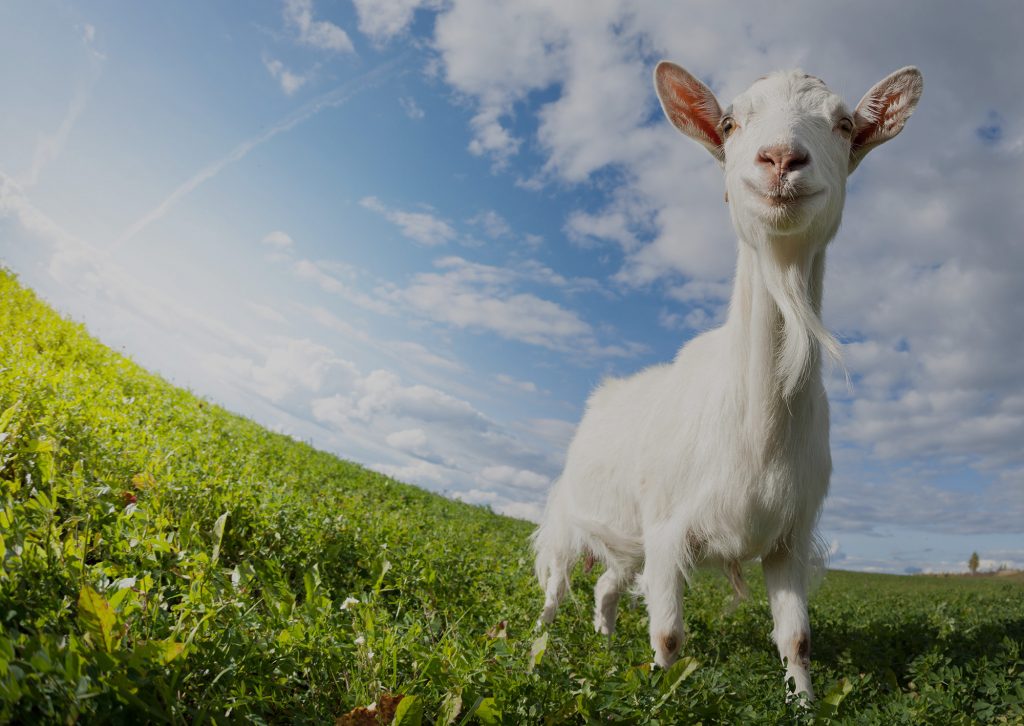
Tannins can be used to counteract the spread of nematodes in the digestive system of goats.
Tannins are an important class of plant secondary metabolites. They are widely distributed in trees and forages such as legumes, cereals and grains. Within plants, condensed tannins are concentrated in cell vacuoles and usually occur in higher concentrations in leaves and reproductive organs.
In terrestrial plants, tannins are classified into condensed tannins and hydrolysable tannins (Zeller, 2019; Jayanegara et al., 2011). Condensed tannins (TC) or “proanthocyanidins” are a large heterogeneous chemical group of phenolic polymers (polyphenols) (Zeller, 2019; Shay et al., 2017).
Hydrolyzable tannins (HT) are a more homogeneous family and are polyesters of gallic acid and various individual sugars (Jayanegara et al., 2011; Makkar, 2003).
Tannins can have both positive and negative effects when they are fed to ruminants, depending mostly on their structure and concentration in the diet.
In addition to the control effect on intestinal nematodes, in several studies, tannins reduced the emission of enteric methane by ruminants (Jayanegara et al., 2011) with positive consequences on the environment.
Due to their chemical structure, tannins have a high affinity with proteins, but also with carbohydrates and metal ions (Makkar, 2003). This affinity leads to the formation of tannins-proteins complex that are not degraded in the rumen. Therefore, tannins reduce protein ruminal degradability, increasing the amount of rumen undegradable proteins (Aboagye and Beauchemin, 2019). This effect is positive because it could lead to an increase in nitrogen use efficiency and to a reduction of urea nitrogen excreted with urine and milk.
On the other hand, the negative effects of tannins are the possible reduction of feeds palatability, the reduction of fiber degradability and some toxic effects when tannins concentration in the diet is greater than 5% of the dry matter.

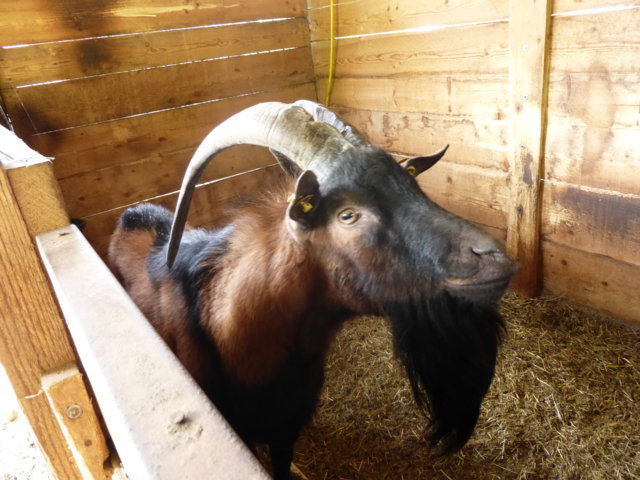
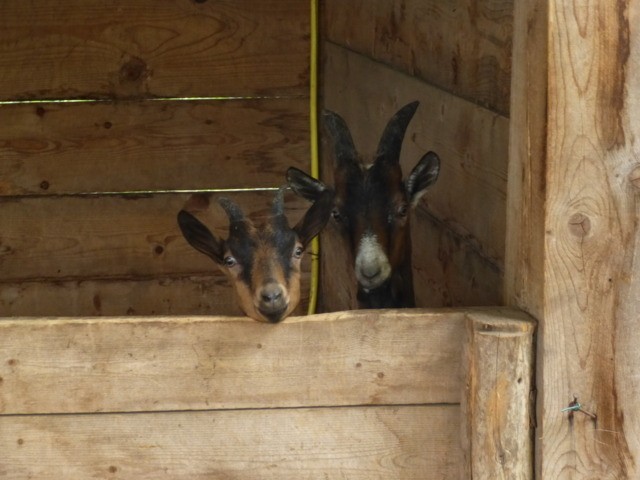
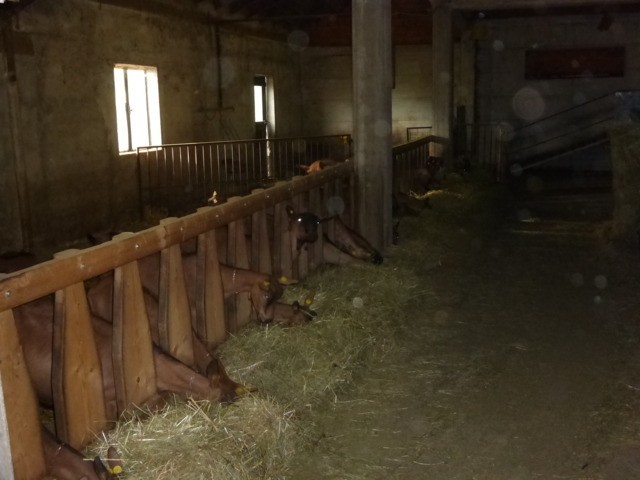


Tannins-rich forages
Among the most common forages, those with the highest concentration of tannins are the legumes birdsfoot trefoil (Lotus corniculatus), sainfoin (Onobrychis viciifolia) and sulla (Hedysarum coronarium).
Birdsfoot trefoil is a short to medium-lived perennial legume, originated from Europe. It does well in areas where annual rainfall ranges from 600 to 1500 mm, and where temperatures are above -5°C during winter and range from 20°C to 30°C during the growing season. Lotus corniculatus does best on soil with a pH ranging from 6.2 to 6.5 or above (Feedipedia.org).
Birdsfoot trefoil is mainly used as fodder, often in association with other plants. Yields vary according to the year, the climatic conditions and the number of possible cuttings: from a yield of 2-3 t/ha in the first year up to 6-14 t/ha of dry matter in optimal conditions (Feedipedia.org). The hay obtained is rich in protein (19.2 ± 2.3% DM) but the quality of the fiber is not very good given the high lignin content (9.6 ± 1.1% DM) (Table 1). In birdsfoot trefoil, condensed tannins vary with percentages from 0.7% to 4% DM (Aboagye and Beauchemin, 2019).
Sainfoin (Onobrychis viciifolia) is an erect, perennial herbaceous legume. It can reach up to a height of 80 cm and its roots are deep tap-roots. Sainfoin flowers twice a year in spring and autumn. Flowering starts with the lower flowers and moves up the stem. Sainfoin is fairly resistant to cold and drought. It adapts to calcareous, sandy, dry soils. It is also suitable for clayey as long as it is not humid, it fears acid soils. Sowing can be done with both bare and dressed seeds with doses ranging from 50 to 160 kg / ha.
As a fodder, it is an excellent plant that improves soil fertility; it remains in cultivation for 2-3 years, placing itself well between two cereals. It has a scarce aptitude for regrowth, the first cut therefore represents the bulk of the production. The yields are 20-25 t/ha of grass, equal to about 4-5 t/ha of hay. Sainfoin hay has a fair content of NDF fiber (47.7 ± 10.6% DM) but with a high lignin content (9.0 ± 1.9% DM), it has a good concentration of protein (15, 2 ± 3.3% DM). It has a condensed tannin content of 1.6-9.4% DM (Aboagye and Beauchemin, 2019).
Sulla (Hedysarum coronarium) is mostly upright, 30-150 cm high with thick, succulent stems that become slightly woody after flowering. It has a deep, branching tap-root (up to 2 m deep), with many secondary roots. The leaves consist of 7-15 pairs of oval leaflets with a single terminal leaflet. They are glabrous above and hairy below. The flower heads are racemes of 10-35 florets, light pink to bright red and crimson, each 3-6 mm long (Feedipedia.org).
Sulla is resistant to drought, but not cold. It adapts well to clayey soils. Sowing can be done in autumn with 80-100 kg/ha of dressed seed or in spring with 20-25 kg/ha of bare seed.
Sulla is an excellent forage enhancer, which fits well between two cereal crops. The first year is used as a pasture. Production for forage is satisfactory only from the second year with an average yield of 4-5 t/ha, all represented by the first and only cut. Due to the high water content, it is better to prefer silage to haymaking.
The hay from Sulla has a good concentration of proteins (14.3 ± 1.7% DM), a fair content of NDF fiber (48.2 ± 6.3% DM) but with a lot of lignin (8.6% DM). It has a tannin content of 3.3-6.8% on dry matter) (Aboagye and Beauchemin, 2019).
Tab. 1. Chemical composition and condensed tannin content of Birdsfoot trefoil (Lotus corniculatus), Sainfoin (Onobrychis viciifolia) and Sulla (Hedysarum coronarium). (Adapted from Feedipedia.org and Aboagye e Beauchemin, 2019).
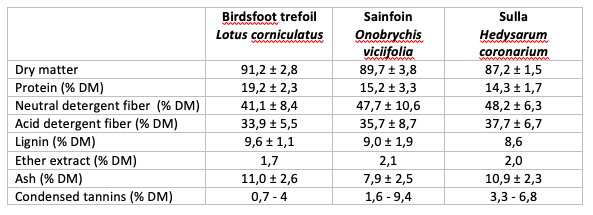
Tannins-rich concentrates
Sorghum (Sorghum bicolor) is an annual herbaceous plant belonging to the Poaceae family. Sorghum roots are adventitious and the root system can extend from the top 90 cm soil layer to twice that depth. Culms are erect, solid, 0.6 to 5 m high and 5 to 30 mm in diameter. Leaves are broad, glabrous, very similar to maize leaves but shorter and broader. Inflorescence is a panicle, around 60 cm long (Feedipedia.org). The grain varies in size and can have colours ranging from white to red to purple. Sorghum is used for both grain and forage.
Sorghum grain has about 12% of moisture, has a high concentration of starch, equal to about 73% of the dry matter, and contains crude proteins for 10.2 ± 1.0% DM, the NDF fiber is about 12.2 ± 1.9% DM, the ethereal extract 3.6 ± 0.3% DM (Feedipedia.org).
Within the grain varieties, there are hybrids without tannins and others with a high content of tannins with concentrations even higher than 50 g / 1000 g of grain. However, due to genetic selection and the erroneous conception that tannins were anti-nutritional elements, varieties with no or very low tannin content are by far the most popular.
Tannins extract
Commercial tannin extracts are derived from woody plants naturally rich in tannins.
Most of purified condensed tannins derive from industrial processes of extraction and purification of tannins especially from quebracho wood (Schinopsis spp.), woody plants belonging to the Anacardiaceae family, but also from mimosa wood (Mimosa spp.), acacia (Acacia spp.) or oak (Quercus spp.).
Purified hydrolysable tannin extracts are obtained with an industrial process similar to that used for condensed tannins and derive mainly from chestnut (Castanea spp.) and oak (Quercus spp.) woods.
Commercial extracts normally have a tannin concentration greater than 70% DM.
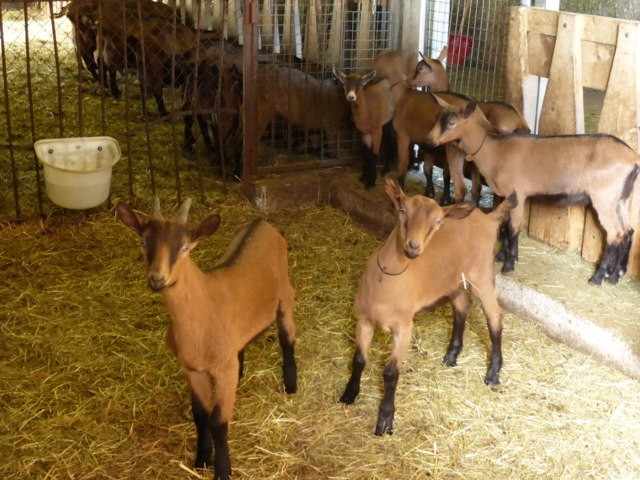
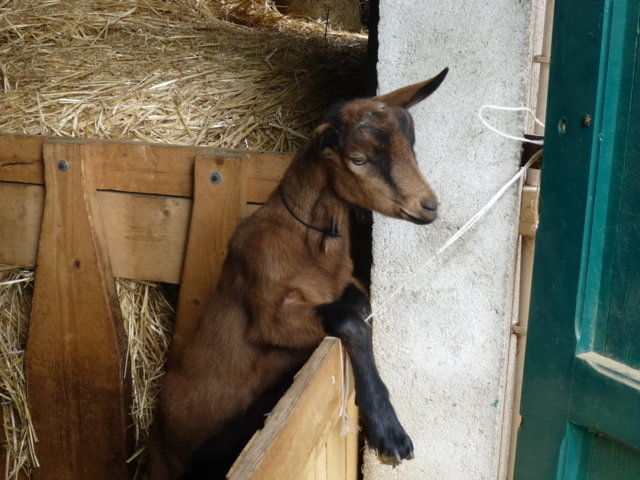
Bibliography
Aboagye I.A., Beauchemin K.A. 2019. Potential of Molecular Weight and Structure of Tannins to Reduce Methane Emissions from Ruminants: A Review. Animals.
doi: 10.3390/ani9110856.
Feedipedia.org (November 2020)
Jayanegara A., Leiber F., Kreuzer M. 2011. Meta‐analysis of the relationship between dietary tannin level and methane formation in ruminants from in vivo and in vitro experiments. Journal of Animal Physiology and Animal Nutrition.
doi:10.1111/j.1439-0396.2011.01172.x
Makkar H.P.S. 2003. Effects and fate of tannins in ruminant animals, adaptation to tannins, and strategies to overcome detrimental effects of feeding tannin-rich feeds. Small Ruminant Research. doi:10.1016/S0921-4488(03)00142-1
Manfredi M.T., Bronzo V., Di Cerbo A. 2011. Allevamento caprino in Lombardia: stato igienico-sanitario e produzioni. Quaderni della ricerca; 129: 1-62. Regione Lombardia Agricoltura.
Manfredi M.T., Di Cerbo A.R., Zanzani S., Stradiotto K. 2010. Breeding management in goat farms of Lombardy, northern Italy: Risk factors connected to gastrointestinal parasites. Small Ruminant Research.
doi:10.1016/j.smallrumres.2009.12.018
Mueller-Harvey I., Bee G., Dohme-Meier F., Hoste H., Karonen M., Kölliker R., Lüscher A.,Niderkorn V, Pellikaan W.F., Salminen J., Skøt L., Smith L.M.J, Thamsborg S.M., Totterdell P., Wilkinson I., Williams A.R., Azuhnwi B.N., Baert N., Brinkhaus A.G.,Copani G., Desrues O., Drake C., Engström M., Fryganas C., Girard M., Huyen N.T.,Kempf K., Malisch C., Mora-Ortiz M.,Quijada J., Ramsay A., Ropiak H.M., Waghorn G.C. 2019. Benefits of Condensed Tannins in Forage Legumes Fed to Ruminants: Importance of Structure, Concentration, and Diet Composition. Crop Sci.
doi:10.2135/cropsci2017.06.0369
Paolini V., Bergeaud J.P., Grisez C., Prevot F., Dorchies Ph., Hoste H. 2003. Effects of condensed tannins on goats experimentally infected with Haemonchus contortus. Veterinary Parasitology.
doi:10.1016/S0304-4017(03)00064-5
Shay P., Trofymow J.A., Constabel C.P. 2017. An improved butanol-HCl assay for quantification of water-soluble, acetone:methanol-soluble, and insoluble proanthocyanidins (condensed tannins). Plant Methods.
doi:10.1186/s13007-017-0213-3
Zeller, W.E. 2019. Activity, Purification, and Analysis of Condensed Tannins: Current State of Affairs and Future Endeavors. Crop Science.
doi:10.2135/cropsci2018.05.0323




